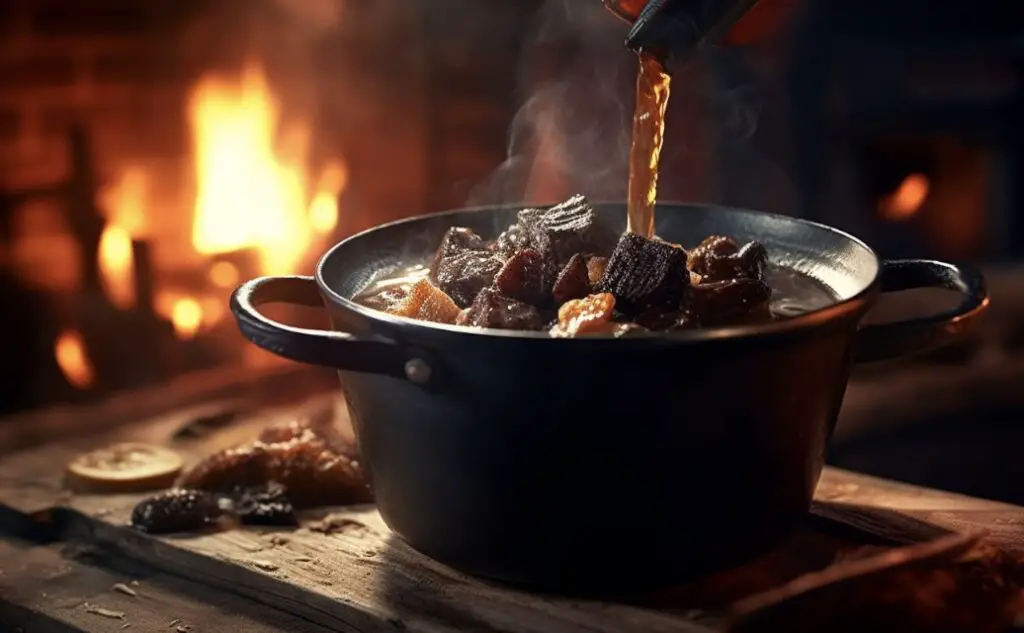The main reason Taylor Port is so strong is its high alcohol content, which usually ranges between 18% and 20%.
This fortified wine is made by adding grape spirit, such as brandy, to the must (grape juice) during the fermentation process. This results in a unique taste and a higher alcohol content compared to other wines.
As an experienced brewer, I’ve had the pleasure of exploring the world of Taylor Port, and in this blog post, I’ll discuss the reasons behind its strength, along with some interesting facts about this fascinating wine.
Why is port wine so strong?
Port wine is known for its high alcohol content, typically ranging from 19% to 22% alcohol by volume (ABV). There are several factors that contribute to the strength of port wine:
1. Fortification: The main reason for the strength of Port is alcohol fortification. Port wine is a fortified wine, which means that a neutral grape spirit (brandy) is added during the fermentation process. This addition of a distilled spirit stops the fermentation, leaving residual sugars and increasing the alcohol content. The fortification process typically occurs when the wine is still sweet, resulting in a higher alcohol level compared to regular table wines.
2. Grape Varieties: Port wine is primarily made from a blend of indigenous grape varieties grown in the Douro Valley region of Portugal. These grapes, such as Touriga Nacional, Touriga Franca, Tinta Roriz, and Tinta Barroca, have naturally high sugar levels and intense flavors. As a result, the fermentation process produces a wine with higher potential alcohol content.
3. Extended Maceration: After the grapes are crushed, the juice and skins are left in contact for an extended period during fermentation. This process, known as maceration, allows for greater extraction of color, tannins, and flavor compounds from the grape skins. The longer maceration period contributes to a more concentrated and robust wine, which can result in higher alcohol levels.
4. Aging: Port wine is often aged in wooden barrels, which allows for oxidation and evaporation over time. This aging process concentrates the flavors, increases the complexity, and further enhances the alcohol content. Vintage ports, in particular, can be aged for several decades, resulting in even higher alcohol levels due to evaporation of water.
It is important to note that the strength of port wine can vary depending on the style and producer. While most port wines fall within the aforementioned alcohol range, there are also lighter styles, such as Ruby or Tawny ports, which have lower alcohol levels.
How much port wine does it take to get drunk?
The amount of port wine required to get drunk can vary significantly from person to person due to factors such as body weight, tolerance, metabolism, and individual alcohol sensitivity. Additionally, the alcohol content of port wine can vary between different brands and styles, ranging typically from 18% to 20% ABV (alcohol by volume).
To provide a general guideline, consuming excessive amounts of alcohol can lead to intoxication and potential health risks. In most countries, moderate drinking is defined as up to one standard drink per day for women and up to two standard drinks per day for men. A standard drink is typically considered to be 14 grams (0.6 ounces) of pure alcohol, which is equivalent to approximately 5 ounces (148 milliliters) of port wine with 20% ABV.
However, it is crucial to be aware that individual tolerance and the effects of alcohol can vary significantly. It is always recommended to drink responsibly, be aware of your limits, and consider factors such as age, health conditions, and any medications you may be taking. If you have concerns about alcohol consumption or its effects, it is advisable to consult with a healthcare professional.
History of Port Wine
The origin of Port wine can be traced back to the Douro Valley in Portugal. The British merchants were searching for an alternative to French wines during the political tensions in the 17th century.

They discovered that adding grape spirit to the wine not only increased its alcohol content but also preserved it for the long journey back to Britain.
Thus, the fortified wine known as Port was born. Taylor Port is a brand of Port wine that has been around for more than three centuries, known for its quality, rich flavor, and high alcohol content.
The Douro Valley and Its Unique Terroir
The Douro Valley, where Port wine is produced, has a unique terroir that contributes to the strength and flavor of Taylor Port. The region has a hot and dry climate, with steep slopes and poor, rocky soils.
This challenging environment forces the vines to struggle, resulting in grapes with a high concentration of sugar, flavor, and color.
The unique conditions of the Douro Valley are essential in producing the intense and robust wines that Port is known for.
The Fortification Process
As mentioned earlier, the fortification process is key to the strength of Taylor Port. During fermentation, grape spirit (usually brandy) is added to the must, which raises the alcohol content and stops the fermentation process.
This leaves residual sugar in the wine, which adds to its sweetness and body. The grape spirit used for fortification is typically around 77% alcohol, resulting in a final alcohol content of 18% to 20% for most Taylor Ports.
Types of Taylor Port
There are several types of Taylor Port, each with its own unique characteristics and strengths. Some of the most popular types include:
– Ruby Port: A young, fruity, and full-bodied wine with an alcohol content of around 19%.
– Tawny Port: Aged in wooden casks for a longer period, Tawny Ports have a nutty flavor and a slightly lower alcohol content of around 18%.
– Vintage Port: Made from the best grapes of a single harvest, Vintage Ports are aged in bottles and can have an alcohol content of up to 20%.
Pairing Taylor Port with Food
The strong flavor and high alcohol content of Taylor Port make it an excellent pairing for rich, flavorful foods. Some classic food pairings for Taylor Port include:
– Blue cheese: The saltiness and creaminess of blue cheese complement the sweetness and richness of Taylor Port.
– Dark chocolate: The bitterness of dark chocolate is a perfect counterbalance to the sweetness of Taylor Port.
– Nuts: Almonds, walnuts, and hazelnuts are a great match for the nutty flavors in Tawny Ports.
Cooking with Taylor Port
In addition to being a delicious drink, Taylor Port can also be used as a cooking ingredient. Its strong flavor and high alcohol content make it an excellent addition to sauces, marinades, and desserts. Some popular recipes using Taylor Port include:
– Port wine reduction sauce: A rich and flavorful sauce that pairs well with beef, pork, or game dishes.
– Port wine poached pears: A sophisticated dessert that showcases the sweetness and complexity of Taylor Port.

Storing and Serving Taylor Port
Due to its high alcohol content, Taylor Port has a longer shelf life than most wines. However, proper storage and serving techniques are essential to maintaining its quality and flavor.
Storing Taylor Port
- Unopened bottles can be stored in a cool, dark place for several years.
- Opened bottles should be sealed with a cork or stopper and stored in the refrigerator. Ruby and Tawny Ports can last for a few weeks, while Vintage Ports should be consumed within a few days.
Serving Taylor Port
- Serve Taylor Port at a slightly chilled temperature, around 55°F to 60°F (13°C to 16°C).
- Use a Port wine glass or a small white wine glass to emphasize the aromas and flavors.
- Decant Vintage Ports to remove any sediment and allow the wine to breathe.
Conclusion
In conclusion, Taylor Port is a strong and flavorful fortified wine that has a rich history and unique production process. Its high alcohol content, derived from the fortification process, sets it apart from other wines and contributes to its distinctive taste. Whether enjoyed on its own, paired with delicious food, or used in cooking, Taylor Port is a versatile and enjoyable drink for any occasion.
10 Facts About Taylor Port:
1. Taylor Port is a fortified wine with a high alcohol content, usually between 18% and 20%.
2. It originated in the Douro Valley in Portugal as an alternative to French wines.
3. The unique terroir of the Douro Valley contributes to the strength and flavor of Taylor Port.
4. The fortification process involves adding grape spirit to the must during fermentation.
5. There are several types of Taylor Port, including Ruby, Tawny, and Vintage.
6. Taylor Port pairs well with rich, flavorful foods such as blue cheese, dark chocolate, and nuts.
7. It can also be used as a cooking ingredient in sauces, marinades, and desserts.
8. Taylor Port has a longer shelf life than most wines due to its high alcohol content.
9. Proper storage and serving techniques are essential for maintaining its quality and flavor.
10. Taylor Port is a versatile and enjoyable drink for any occasion, appreciated by wine enthusiasts around the world.
FAQs
How is port supposed to be drunk?
Port is typically served as a dessert wine and is best enjoyed at a slightly cooler temperature than room temperature, around 55-65°F (12-18°C). Here are the traditional ways to drink port:
1. Glassware: Port is traditionally served in smaller, tulip-shaped glasses called port or sherry glasses. These glasses help concentrate the aromas and flavors of the wine.
2. Decanting: Vintage ports, which are aged in the bottle and often have sediment, should be decanted to separate the wine from any sediment. Pour the port slowly into a decanter, leaving any sediment in the bottle. Non-vintage ports or those without sediment can be served directly from the bottle.
3. Serving size: Port is typically served in smaller quantities, usually around 2-3 ounces (60-90 ml) per serving. Its rich and concentrated flavors make it a wine to be savored slowly.
4. Temperature: Depending on the style of port, it can be served at different temperatures. Ruby and tawny ports are usually enjoyed slightly chilled, around 55-60°F (12-15°C), to enhance their fruity and vibrant characteristics. Vintage ports, on the other hand, benefit from being served at a slightly warmer temperature, around 60-65°F (15-18°C), to allow their complex flavors to fully develop.
5. Pairings: Port pairs wonderfully with a variety of desserts, such as chocolate, nuts, and aged cheeses. It can also be enjoyed on its own as a digestif. The sweetness and richness of port make it a delightful complement to these flavors.
6. Sipping: Take small sips of port, allowing it to coat your palate and fully appreciate its flavors. Swirl the wine in your glass to release its aromas and take note of the complex notes of fruit, spice, and sometimes nuttiness that are characteristic of port.
Remember, personal preferences may vary, so feel free to experiment and find the style and serving method that you enjoy the most.
Does Taylor Port get you drunk fast?
Taylor Port is a fortified wine with an alcohol content of around 20%, which is higher than most regular wines. The higher alcohol content means that consuming Taylor Port can lead to feeling the effects of alcohol more quickly than when consuming beverages with lower alcohol content. However, the rate at which someone gets drunk depends on various factors, including body weight, metabolism, tolerance, and the amount consumed. It is important to consume alcohol responsibly and be aware of personal limits to avoid excessive alcohol consumption and its potential negative effects.
Does Port give you a hangover?
Like any alcoholic beverage, consuming Port wine can potentially lead to a hangover if consumed in excess. Hangovers are primarily caused by the consumption of alcohol, which is a diuretic and can lead to dehydration. Additionally, alcohol can cause inflammation, disrupt sleep patterns, and irritate the stomach lining, all of which can contribute to the symptoms commonly associated with a hangover.
Does port get you drunk quickly?
Port, like any other alcoholic beverage, can contribute to intoxication and getting drunk quickly. However, the speed at which alcohol affects an individual’s level of intoxication depends on various factors, including the alcohol content of the port, the quantity consumed, the individual’s body weight, metabolism, tolerance, and other physiological factors.




